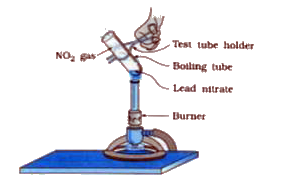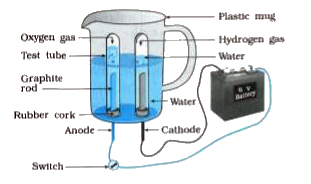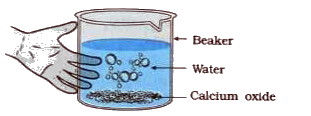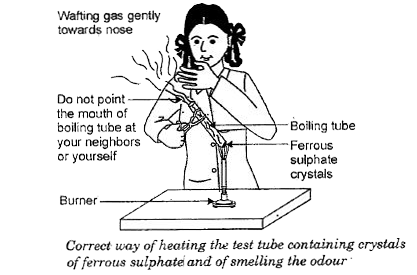Aim : To study the decomposition of ferrous sulphate on heating
Activity:
Take approximately 2 g of ferrous sulphate crystals in a dry boiling tube.
Heat the boiling tube over the flame of a burner.
Observe the colour of the ferrous sulphate crystals carefully during the heating.
Observe the colour of the crystals after heating it.

Which colour is observed on heating the crystals of ferrous sulphate ?Solution in Gujrati
On heating the ferrous sulphate, it is decomposed into Fe2O3 and green colour changes to (reddish) brown.
Topper's Solved these Questions
- CHEMICAL REACTIONS AND EQUATIONS BOOK - KUMAR PRAKASHANCHAPTER - CHEMICAL REACTIONS AND EQUATIONS EXERCISE - QUESTIONS AND ANSWERS (ACTIVITY) 1.6
2 Videos
- CHEMICAL REACTIONS AND EQUATIONS BOOK - KUMAR PRAKASHANCHAPTER - CHEMICAL REACTIONS AND EQUATIONS EXERCISE - QUESTIONS AND ANSWERS (ACTIVITY) 1.7
5 Videos
- CHEMICAL REACTIONS AND EQUATIONS BOOK - KUMAR PRAKASHANCHAPTER - CHEMICAL REACTIONS AND EQUATIONS EXERCISE - QUESTIONS AND ANSWERS (ACTIVITY 1.4)
4 Videos
- CARBON AND ITS COMPOUNDSBOOK - KUMAR PRAKASHANCHAPTER - CARBON AND ITS COMPOUNDSEXERCISE - Practical Skill Based Questions With Answers
10 Videos
- METALS AND NON-METALSBOOK - KUMAR PRAKASHANCHAPTER - METALS AND NON-METALSEXERCISE - PRACTICE SKILL BASED QUESTIONS WITH ANSWERS
5 Videos
Similar Questions
Aim : To study the decomposition of lead nitrate.
Activity:
Take about 2g of lead nitrate powder in a boiling tube.
Hold the boiling tube with a pair of tongs and heat it over the flame of a burner.

Which gas is evolved from boiling tube on heating lead nitrate ?
View SolutionAim: To study electrolysis of water.
Activity:
Take a plastic mug. Drill two holes at the base of the mug. Fix two rubber corks in it, as shown in the figure 1.6.
Arrange the test tubes in inverted position such that carbon electrodes remains in it as shown in the figure.
Add water in a mug such that electrodes are immersed.
Add a few drops of dilute sulphuric acid to water.
Connect electrodes to a 6 volt battery.
Now, switch on the current and leave the apparatus undisturbed for some time.

What is an electrode ?
View SolutionAim: To study the reaction between calcium oxide and water.
Activity:
Take some quick lime (Calcium oxide - CaO) in a beaker. Add water to it slowly.
Touch the beaker as shown in the figure 1.3.

What is formed by reaction of quick lime with water ? Write reaction.
View SolutionAn organic compound 'A' is widely used to preserve the pickles and has a molecular formula C2H4O2. This compound reacts with ethanol to form a sweet smelling compound 'B'.
Identify the compound 'A'.
View SolutionMention three safety measures essential while performing the reactivity series experiment in the laboratory
View Solution(a) What is the colour of ferrous sulphate crystals ? How does this colour change after heating?
(b) Name the product formed on strongly heating ferrous sulphate crystals. What type of chemical reaction occurs in this change?
View Solution2g of ferrous sulphate crystals are heated in a boiling tube.
(i) State the colour of ferrous sulphate crystals both before heating and after heating.
(ii) Name the gases produced during heating.
(iii) Write the chemical equation for the reaction.
View SolutionThe crystals of ferrous sulphate on heating give :
View Solution(a) What is the colour of ferrous sulphate crystals ? How does this colour change after heating?
(b) Name the product formed on strongly heating ferrous sulphate crystals. What type of chemical reaction occurs in this change?
View Solution2g of ferrous sulphate crystals are heated in a boiling tube.
(i) State the colour of ferrous sulphate crystals both before heating and after heating.
(ii) Name the gases produced during heating .
(iii) Write the chemical equation for the reaction .
View Solution2g of ferrous sulphate crystals are heated in a boiling tube. (i) State the colour of ferrous sulphate crystals both before heating and after heating. (ii) Name the gases produced during heating. (iii) Write the chemical equation for the reaction.
View SolutionAim : To study the decomposition of ferrous sulphate on heating Activity: Take approximately 2 g of ferrous sulphate crystals in a dry boiling tube. Heat the boiling tube over the flame of a burner. Observe the colour of the ferrous sulphate crystals carefully during the heating. Observe the colour of the crystals after heating it. What is the colour of crystals of ferrous sulphate ?
View SolutionAim : To study the decomposition of ferrous sulphate on heating Activity: Take approximately 2 g of ferrous sulphate crystals in a dry boiling tube. Heat the boiling tube over the flame of a burner. Observe the colour of the ferrous sulphate crystals carefully during the heating. Observe the colour of the crystals after heating it. On heating ferrous sulphate in boiling tube, a gas evolved which has a characteristic smell. What is its reason ?
View SolutionThe crystals of ferrous sulphate on heating give:
View Solution•Take about 2 g ferrous sulphate crystals in a dry bottle tube.
• Note the colour of the ferrous sulphate crystals.
• Heat the boiling tube over the flame of a burner or spirit lamp as shown in Fig.

Observe the colour of the crystals after heating.
View Solution
